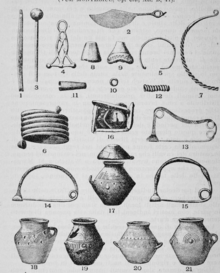Proto-Villanovan culture
show This article may be expanded with text translated from the corresponding article in Italian. (November 2014) Click [show] for important translation instructions. |
 | |
| Geographical range | Europe |
|---|---|
| Period | Bronze Age |
| Dates | c. 1200–901 BC |
| Preceded by | Urnfield culture |
| Followed by | Villanovan culture, Latial culture, Este culture |
The Proto-Villanovan culture was a late Bronze Age culture that appeared in Italy in the first half of the 12th century BC and lasted until the 10th century BC, part of the central European Urnfield culture system (1300-750 BCE).
History[]
Proto-Villanovan culture was part of the central European Urnfield culture system. Similarity has also been noted with the regional groups of Bavaria-Upper Austria[1] and of the middle-Danube.[1][2] Another hypothesis, however, is that it was a derivation from the previous Terramare culture of the Po Valley.[3][4] Various authors, such as Marija Gimbutas, associated this culture with the arrival, or the spread, of the proto-Italics into the Italian peninsula.[1]
Proto-Villanovan sites are present all over the Italian peninsula, mostly in the northern-central part but also, to a lesser degree, in Southern Italy and eastern Sicily. Among the most important of these sites are: Frattesina (Veneto), Bismantova and (Emilia-Romagna), Cetona and Saturnia (Tuscany), Monti della Tolfa (Lazio), Pianello di Genga (Marche), Ortucchio (Abruzzo), (Basilicata), Canosa (Apulia), Tropea (Calabria) and Milazzo (Sicily).
Settlements, usually of small dimensions, were generally built on hills and circumscribed with fortifications. The economy was mostly based on agro-pastoral activities, metallurgy and trades.
The proto-Villanovans practiced cremation. The ashes were placed in biconic urns, often decorated with geometric designs, and then buried in the ground.
Regionalization[]
After a period of considerable uniformity from north to south, the Proto-Villanovan culture shows a process of regionalization. Starting from c. 950 BC, new regional cultures such as the Villanovan culture, Este culture and Latial culture appeared. Although these new cultures shared many similarities with the preceding Proto-Villanovan culture, especially funerary customs, they also exhibited their own innovations.
Genetics[]
A genetic study published in Science in November 2019 examined the remains of a female from the Proto-Villanovan culture buried in Martinsicuro, Italy between ca. 930 BC and 839 BC, in the territory of the Picentes. She carried the maternal haplogroup U5a2b.[5]
References[]
- ^ Jump up to: a b c M. Gimbutas Bronze Age Cultures in Central and Eastern Europe pp. 339–345
- ^ John M. Coles The Bronze Age in Europe: An Introduction to the Prehistory of Europe C. 2000–700 BC, pp. 422
- ^ Andrea Cardarelli The collapse of the Terramare culture and growth of new economic and social system during the late Bronze Age in Italy
- ^ Francesco di Gennaro. "Protovillanoviano", Enciclopedia dell'arte antica, Treccani, Rome, 1996
- ^ Antonio et al. 2019, Table 2 Sample Information, Row 36.
Sources[]
- Antonio, Margaret L.; et al. (November 8, 2019). "Ancient Rome: A genetic crossroads of Europe and the Mediterranean". Science. American Association for the Advancement of Science. 366 (6466): 708–714. doi:10.1126/science.aay6826. PMC 7093155.
See also[]
- Villanovan culture
- Latial culture
- Este culture
| Wikimedia Commons has media related to Proto-Villanovan culture. |
- 12th-century BC establishments
- 10th-century BC disestablishments
- Urnfield culture
- Archaeological cultures of Southern Europe
- Archaeological cultures in Italy
- Italic archaeological cultures
- Bronze Age cultures of Europe
- Villanovan culture
- European archaeology stubs
- Italian history stubs